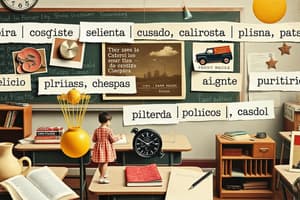Podcast
Questions and Answers
Match the following classroom procedures with their objectives:
Match the following classroom procedures with their objectives:
Entry Protocol = Teaches orderliness and patience Toy Rotation = Ensures fairness and cooperation Rest Time = Teaches self-soothing techniques Snack Time = Teaches appropriate table manners and sharing habits
Match the following classroom procedures with their activities:
Match the following classroom procedures with their activities:
Toy Rotation = Following specific guidelines when choosing toys Clean Up = Participating in cleanup tasks like putting away materials Rest Time = Designating quiet spaces with mats or pillows for naps or resting periods Entry Protocol = Lining up in groups outside the classroom door and waiting patiently
Match the following classroom procedures with the outcomes they aim to achieve:
Match the following classroom procedures with the outcomes they aim to achieve:
Rest Time = Teaching self-soothing techniques Toy Rotation = Ensuring fairness and cooperation among children Snack Time = Promoting respectful behavior among peers Clean Up = Fostering responsibility in children
Match the following classroom procedures with their benefits for children:
Match the following classroom procedures with their benefits for children:
Match the following classroom procedures with the skills they help develop in children:
Match the following classroom procedures with the skills they help develop in children:
Flashcards are hidden until you start studying
Study Notes
Pre-Kindergarten Classroom Rules – Daily Routines & Procedures
As children transition from home life to school life, pre-kindergarten classrooms play a crucial role in preparing them for future learning environments. Establishing clear classroom rules helps create structure and consistency within the classroom setting. Here we explore some common pre-kindergarten classroom rules related to daily routines and procedures.
Daily Routines
Establishing consistent daily routines is essential for young learners. Pre-schools often have predictable schedules with designated times allocated to various activities such as snack time, outside play, circle time, and nap time. It's also important to set expectations around arrival, dismissal, bathroom breaks, and mealtime manners. For example, students may need to wash their hands before eating and after using the restroom. Similarly, they might be encouraged to put personal belongings away during certain parts of the day, such as during storytime, art projects, or outdoor playground sessions.
Classroom Procedures
Clear and concise classroom procedures help maintain a smooth flow throughout the day. These procedures can cover various aspects of the classroom routine, including how to enter and exit the room, where to place backpacks and coats, and what to do if someone needs assistance while others are working quietly. Consistent communication of these procedures ensures all members of the classroom community understand their roles and responsibilities, promoting respectful behavior among peers.
Examples of Classroom Procedures Include:
-
Entry Protocol: Students line up in groups outside the classroom door and wait patiently for the teacher to invite them inside one by one. This teaches orderliness and patience.
-
Toy Rotation: Children must follow specific guidelines when choosing toys, ensuring fairness and cooperation.
-
Rest Time: Teachers designate quiet spaces with mats or pillows for naps or resting periods, teaching self-soothing techniques.
-
Snack Time: Students learn appropriate table manners and sharing habits during communal meals.
-
Clean Up: At the end of each activity, children participate in cleanup tasks like putting away materials or organizing their desks, fostering responsibility.
Conclusion
The key to successful pre-kindergarten classroom rules lies in maintaining regularity across daily routines and procedures. Predictability offers comfort and security for young learners. As they become more familiar with the routine, children develop independence and confidence as they navigate through the structured environment.
Studying That Suits You
Use AI to generate personalized quizzes and flashcards to suit your learning preferences.




